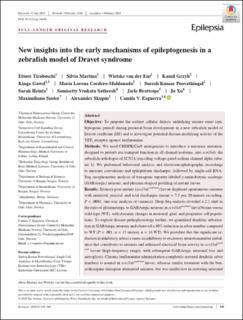| dc.contributor.author | Tiraboschi, Ettore | |
| dc.contributor.author | Martina, Silvia | |
| dc.contributor.author | van der Ent, Wietske | |
| dc.contributor.author | Grzyb, Kamil | |
| dc.contributor.author | Gawel, Kinga | |
| dc.contributor.author | Cordero-Maldonado, Maria Lorena | |
| dc.contributor.author | Poovathingal, Suresh K. | |
| dc.contributor.author | Heintz, Sarah | |
| dc.contributor.author | Satheesh, Somisetty Venkata | |
| dc.contributor.author | Brattespe, Jarle | |
| dc.contributor.author | Xu, Ju | |
| dc.contributor.author | Suster, Maximiliano | |
| dc.contributor.author | Skupin, Alexander | |
| dc.contributor.author | Esguerra, Camila V. | |
| dc.date.accessioned | 2021-05-07T11:40:42Z | |
| dc.date.available | 2021-05-07T11:40:42Z | |
| dc.date.created | 2021-01-12T15:24:42Z | |
| dc.date.issued | 2020 | |
| dc.Published | Epilepsia. 2020, 61 (3), 549-560. | |
| dc.identifier.issn | 0013-9580 | |
| dc.identifier.uri | https://hdl.handle.net/11250/2754164 | |
| dc.description.abstract | Abstract Objective: To pinpoint the earliest cellular defects underlying seizure onset (epileptogenic period) during perinatal brain development in a new zebrafish model of Dravet syndrome (DS) and to investigate potential disease-modifying activity of the 5HT2 receptor agonist fenfluramine. Methods: We used CRISPR/Cas9 mutagenesis to introduce a missense mutation, designed to perturb ion transport function in all channel isoforms, into scn1lab, the zebrafish orthologue of SCN1A (encoding voltage-gated sodium channel alpha subunit 1). We performed behavioral analysis and electroencephalographic recordings to measure convulsions and epileptiform discharges, followed by single-cell RNA-Seq, morphometric analysis of transgenic reporter-labeled γ-aminobutyric acidergic (GABAergic) neurons, and pharmacological profiling of mutant larvae. Results: Homozygous mutant (scn1labmut/mut ) larvae displayed spontaneous seizures with interictal, preictal, and ictal discharges (mean = 7.5 per 20-minute recording; P < .0001; one-way analysis of variance). Drop-Seq analysis revealed a 2:1 shift in the ratio of glutamatergic to GABAergic neurons in scn1labmut/mut larval brains versus wild type (WT), with dynamic changes in neuronal, glial, and progenitor cell populations. To explore disease pathophysiology further, we quantified dendritic arborization in GABAergic neurons and observed a 40% reduction in arbor number compared to WT (P < .001; n = 15 mutant, n = 16 WT). We postulate that the significant reduction in inhibitory arbors causes an inhibitory to excitatory neurotransmitter imbalance that contributes to seizures and enhanced electrical brain activity in scn1labmut/mut larvae (high-frequency range), with subsequent GABAergic neuronal loss and astrogliosis. Chronic fenfluramine administration completely restored dendritic arbor numbers to normal in scn1labmut/mut larvae, whereas similar treatment with the benzodiazepine diazepam attenuated seizures, but was ineffective in restoring neuronal cytoarchitecture. BrdU labeling revealed cell overproliferation in scn1labmut/mut larval brains that were rescued by fenfluramine but not diazepam. Significance: Our findings provide novel insights into early mechanisms of DS pathogenesis, describe dynamic cell population changes in the scn1labmut/mut brain, and present first-time evidence for potential disease modification by fenfluramine. Keywords: Dravet syndrome; epileptogenesis; fenfluramine; sodium channel; zebrafish. | en_US |
| dc.language.iso | eng | en_US |
| dc.publisher | Wiley | en_US |
| dc.relation.uri | https://onlinelibrary.wiley.com/doi/full/10.1111/epi.16456 | |
| dc.rights | Navngivelse-Ikkekommersiell 4.0 Internasjonal | * |
| dc.rights.uri | http://creativecommons.org/licenses/by-nc/4.0/deed.no | * |
| dc.title | New insights into the early mechanisms of epileptogenesis in a zebrafish model of Dravet syndrome | en_US |
| dc.type | Journal article | en_US |
| dc.type | Peer reviewed | en_US |
| dc.description.version | publishedVersion | en_US |
| dc.rights.holder | Copyright 2020 The Authors. | en_US |
| cristin.ispublished | true | |
| cristin.fulltext | original | |
| cristin.qualitycode | 1 | |
| dc.identifier.doi | https://doi.org/10.1111/epi.16456 | |
| dc.identifier.cristin | 1869986 | |
| dc.source.journal | Epilepsia | en_US |
| dc.source.40 | 61 | |
| dc.source.14 | 3 | |
| dc.source.pagenumber | 549-560 | en_US |
| dc.relation.project | Norges forskningsråd: 187615 | en_US |
| dc.identifier.citation | Epilepsia. 2020, 61, (3), 549-560 | en_US |
| dc.source.volume | 61 | en_US |
| dc.source.issue | 3 | en_US |

